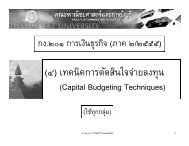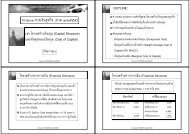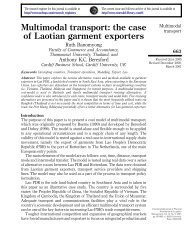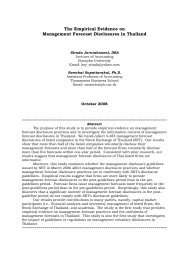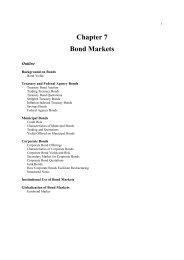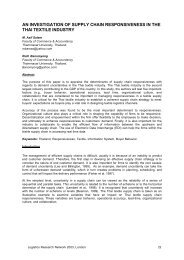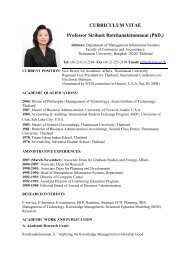The Role of Communication Strategies in Change Management ...
The Role of Communication Strategies in Change Management ...
The Role of Communication Strategies in Change Management ...
You also want an ePaper? Increase the reach of your titles
YUMPU automatically turns print PDFs into web optimized ePapers that Google loves.
Somboon Kulvisaechana<br />
2.2.3 Issues <strong>of</strong> <strong>Communication</strong> for <strong>Change</strong><br />
Organizational scholars have long acknowledged the importance <strong>of</strong> communication processes<br />
<strong>in</strong> explanations <strong>of</strong> organizational change processes (Lewis and Seibold, 1996; Rogers, 1995;<br />
Fairhurst and Wendt, 1993). Nonetheless, Lewis (2000a) argues that the systematic research<br />
about the effectiveness <strong>of</strong> communication strategies about change is scant. Carmichael<br />
(1996) supports Lewis’s argument by depict<strong>in</strong>g that academics and practitioners have tried to<br />
search for a complete, well-grounded def<strong>in</strong>ition <strong>of</strong> communication for change, but their<br />
efforts primarily have focused on the <strong>in</strong>vention, design, adoption, and responses to planned<br />
organizational change, as well as outcomes <strong>of</strong> change efforts. In addition, central<br />
communication processes <strong>in</strong>volved <strong>in</strong> the implementation <strong>of</strong> planned changes with<strong>in</strong><br />
organizations have received far less attention by communication scholars (Lewis, 2000a).<br />
2.2.3.1 Impediments <strong>of</strong> <strong>Communication</strong> for <strong>Change</strong><br />
<strong>Communication</strong> problems are commonplace when changes are not clearly identified (Lewis,<br />
2000b). Not only do they cause a dra<strong>in</strong> on pr<strong>of</strong>itability, but also the effectiveness <strong>of</strong><br />
management decl<strong>in</strong>es (Gilsdorf, 1998). In the work <strong>of</strong> Dawson (1996: p. 192), many<br />
underly<strong>in</strong>g reasons why communication <strong>of</strong>ten falls short <strong>of</strong> the ideals, which are “accuracy,<br />
reliability, validity, adequacy, and effectiveness,” are addressed with some general issues<br />
with<strong>in</strong> the relationship between <strong>in</strong>formation and communication <strong>in</strong> organizations. 2<br />
Accord<strong>in</strong>g to Lewis (2000b)’s research f<strong>in</strong>d<strong>in</strong>gs, the most frequently noted categories <strong>of</strong><br />
problem encountered by the company <strong>in</strong> transition are “communicat<strong>in</strong>g vision” and “negative<br />
attitudes.” If an organization’s management does not consider which communication<br />
behaviors it wishes to foster for its success, the signals it sends to employees may be<br />
<strong>in</strong>consistent or counterproductive. Thus, managers should consider convey<strong>in</strong>g clear<br />
communication-behavior expectations as a fundamental element <strong>of</strong> strategy. In do<strong>in</strong>g so,<br />
firms might pursue communication audits which <strong>in</strong>volve ethnographic analysis, <strong>in</strong>clud<strong>in</strong>g<br />
observation and <strong>in</strong>terview<strong>in</strong>g, to learn exactly what organizational policies are operat<strong>in</strong>g<br />
(Gilsdorf, 1998). Moreover, Gilsdorf moves on to argue that analysis <strong>of</strong> organizational<br />
culture should be conducted <strong>in</strong> order to help determ<strong>in</strong>e the communication strategy used to<br />
solve the problem.<br />
22




